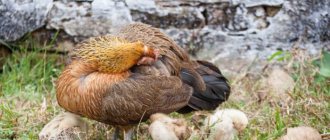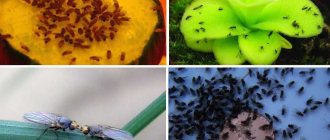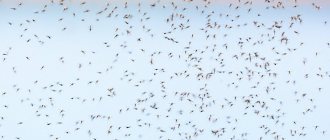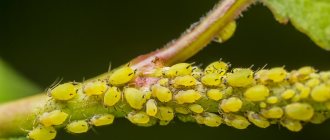Preparing in advance for the gardening season includes the hassle of choosing planting material and sowing seedlings. Even fully urbanized residents of megacities are not immune from them: exotic indoor flowers are often propagated by seeds. However, not everyone can provide thorough agricultural technology and midges in seedlings often appear even among experienced summer residents. At the same time, many ways have been invented to get rid of this misfortune: from chemical to henchmen.

What are the midges
The group of insects, which are called midges, include domestic flies of fruit flies, soil (mushroom) mosquitoes, lacewings, whiteflies. Fruit flies of Drosophila prefer to feed on rotting plant debris, but they do not refuse fresh seedling juice either.
Green lacewings do not harm plants because they are predators and feed on aphids that settle on seedlings. Mushroom mosquitoes (sciarum fly) in the larval stage eat up the roots of the seedlings. Whiteflies, both in adulthood and in the larval stage, are capable of completely destroying the plant.
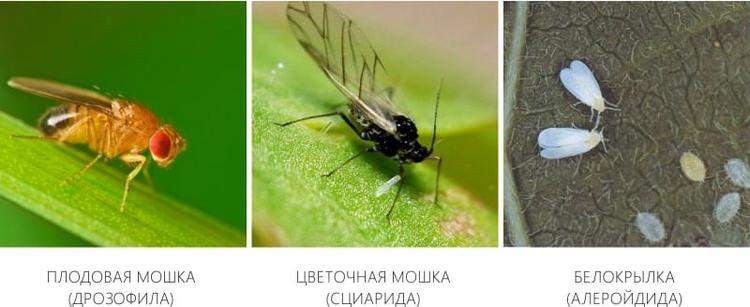

What harm do midges do
Some types of these pests are absolutely safe for plants, for example, black ones. Larvae of insects, which can damage the roots, are of great danger.
White midges are most dangerous - at all stages of development, they feed on plant juices. And this weakens the immunity of vegetables and can in a short time destroy all the work on planting and growing fruits.
Paw tails, which are also called mints, have a size of up to 1 mm. They are safe for plants. Only a separate species of them - green smintur - is capable of causing harm to seedlings in greenhouses.
Among other things, midges are dangerous to humans. Females are known to feed on blood, which is why they bite humans and animals. Their bites are extremely unpleasant, because the insect does not pierce the skin, but bites into it. After a bite, a person feels itching and burning, red dots or blisters appear on his body.
In most cases, such skin lesions are easily treated and there are no unpleasant consequences. However, with the wrong treatment, the situation can worsen:
- the body of children, people prone to allergic reactions, pregnant and lactating women can react to enzymes injected by midges and provoke the development of allergies;
- with a bite in the eye, there is a risk of loss of vision;
- bite wounds can become infected and fester.


With numerous insect bites, nausea and weakness, dizziness may occur
Important to remember! Precautions must be taken, and in case of a reaction to a midge bite, you should promptly consult a specialist or use a drug, for example, Fenistil Gel.
Causes of the appearance of midges
Midges in an apartment can appear at any time of the year. The main thing is that the temperature and humidity correspond to the conditions of their habitation. They are able to fly into a dwelling from a damp basement through ventilation shafts, pipes, hoods; through open vents, windows, doors; hatch from eggs laid on fruits or vegetables intended for winter storage.
They can be purchased along with seedling soil. A garbage can taken out at the wrong time, a very wet soil mixture that has not been treated before sowing seeds becomes a refuge for insects and their larvae.
Application of insecticides
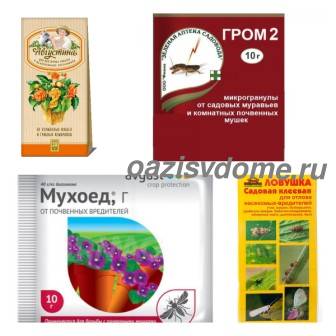

It is advisable to use special remedies for small flies in seedlings as a last resort:
- Mashenka crumbles chalk and powders the earth with it.
- Powders Flycatcher and Thunder-2 they will quickly destroy pests if you sprinkle the soil with granules and water it.
- Insecticides use strictly according to the instructions attached to them. After application, be sure to ventilate the room. The most popular of them are Inta-vir, Bazudin, Fitoverm.
- Universal remedies that will destroy flying flies and larvae are familiar to everyone aerosols: Dichlorvos, Reid other. They are sprayed on the ground from above and the air around.
You will be interested to know: Spraying with urea in the fall: how and when to treat the garden with urea
Before sowing seeds for seedlings, be sure to disinfect the soil so that no pests remain in it. In the future, as a preventive measure, you need to moderately water the plants, regularly loosen the soil and fertilize the soil with high quality. Also try not to thicken the planting. This is very important not only because of the threat of midges appearing in seedlings. The sufficiency of light and nutrition is the key to the development of good and strong plants, on which the final harvest directly depends.
Midges have bred in the seedlings, what to do
Midges feel great where it is warm, where food debris rot in a garbage bag, pieces of fruit roll around in an inaccessible place, compote sours in a cup. But, if everything is clean and dry, the midges have to look for a place where they can find food and lay eggs.
They will always find the environment necessary for their nutrition and reproduction on the surface of a waterlogged soil substrate in a box with seedlings. Therefore, the first thing to do to deprive insects of their breeding sites is to dry the soil under the plants.
Do not water the seedlings until the topsoil dries out. If it so happens that after watering the earthen lump will become too wet, you should try to dry it as quickly as possible, for example, by placing the seedling pots above the heat sources. You have to be careful not to boil the plants.
If excess water drains into the lower pan, the liquid will need to be drained so that it does not rise again through the bottom of the container to the top of the pot. Then watering can be done through this sump, pouring water into it.
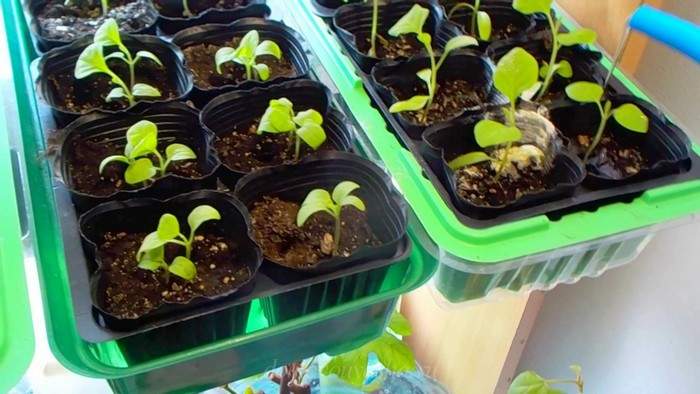

Preventive measures
Reasons for the appearance
So that you do not have to look for ways to deal with annoying flower midges, prevent their appearance. Subject to the basic rules of care, you will not have to get acquainted with these insects:
- Observe the watering regime. Then the soil will not be waterlogged. Water the plants when the soil dries up by 1–2 cm.
- Loosen the soil one day after watering.
- Remove fallen leaves and flowers in time to prevent decay.
- Calcine the new soil even if the supplier has already proven itself to be good.
- Use a quality fertilizer suitable for your particular plant species. Read the instructions so as not to pour too much.
- Use drainage.
- Ventilate the room with flowers.


The appearance of midges in flowers is a sign that the plants need help. Give them some time and they will thank you for a pleasant atmosphere in the house.
How to get rid of midges with folk remedies
It is not always possible to dry the soil quickly, and the number of larvae in the ground may be such that it will be impossible to hesitate. Then you will have to transplant the plants into new soil, other pots or boxes, after sterilizing everything. Simultaneously with the transplant, it is necessary to carry out measures to destroy adult flying individuals.
You can start by using a flying insect killer or a mosquito and fly repellent fumigator.If the seedlings are located in a place where there is no electrical wiring, then it is necessary to hang adhesive fly traps in the nursery or set fire to a mosquito coil.
Preparing the soil for transplanting seedlings must be taken with full responsibility. It is not enough to simply buy potting soil at a garden store and spill it with boiling water. You need to load it in the microwave for 2-3 minutes or fry in the oven for 20-30 minutes. If this cannot be done, then the subsequent treatment with water with potassium permanganate diluted in it is added to the processing of the land with boiling water. The color of the water should be deep pink. Disinfection is for boxes, pallets, pots and tools that will be used for transplanting.
The soil, before transplanting seedlings into it, must be dried to the state of a coma crumbling in the hands.
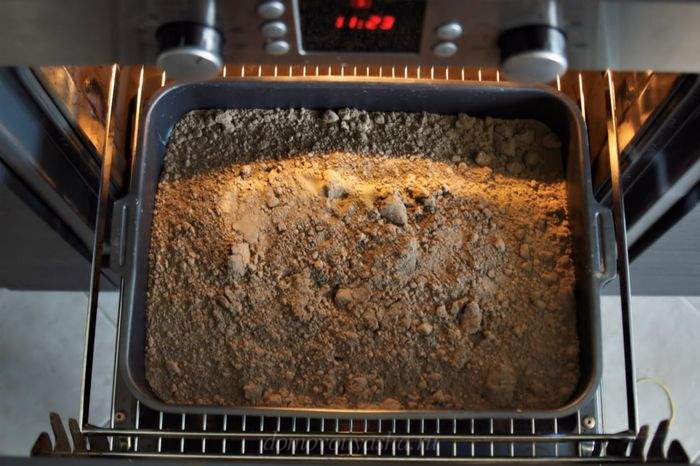

So that eggs and larvae of pests do not get into the fresh soil again, the roots of the plant and the lower parts of the stems are freed from the ground, lowered for 3-5 seconds in a weak solution of potassium permanganate and carefully examined.
If there are no pots to transplant the plants into, you can only replace 2 to 3 cm of the top of the soil on the surface of the pot. Several granules of soil insecticide are added to the new soil layer. After that, a layer of drainage materials with a thickness of 1 cm is laid on the surface of the soil.
Indoor midges and seedlings ?!
Hello dear visitor!
This material will about a not entirely positive result, which I suddenly received for the first time in 16 years when growing my own seedlings.
It seemed that everything was as usual but suddenly, out of nowhere, ... a problem popped up. Yes, not even a problem, but a disaster. Well, let's go in order ...
You know there is such a tiny midge, which appears in the apartment if there is rotten food. For example, we have this midge appeared in the apartment at the end of the summer season in 2014.
After they brought the apples from the dacha, and, as usual, they lay on the balcony in a bag and waited for processing (compote, jam, jam, etc.). Well, when I went out onto the balcony, I saw these midges, and they were completely harmless.
Then, with the onset of cold weather, this midge migrated from the balcony to the apartment. In the apartment, of course, she had nothing to profit from, and she seemed to have disappeared over time, but not all, only a few specimens remained, which, most likely, settled in the soil of flower pots.
During the winter they were not visible, but by the spring they began to appear and flew around the apartment here and there. As far as possible, I caught them, of course, but, you understand, it was not possible to catch them all.
In March 2020 I sowed means, seeds of tomatoes and peppers for seedlings, mulched the soil in seedling boxes with a thin layer of chopped straw.
Young sprouts appeared and the seedlings grew normally. Over time, I took the seedlings out to the balcony for hardening, and everything was fine. Then he planted the seedlings in open ground - the plants grew, bloomed and yielded crops. In general, everything was as usual.
Let's go further ...
In March 2020, as always, I sowed seeds of tomatoes and peppers for seedlings and then the unexpected happened? I sowed pepper seeds early this year, as I calculated the timing of planting these seedlings in a new greenhouse, which my brother and I plan to put in the near future.
For some reason, the seeds did not hatch for a long time, but still, after 12-14 days, cotyledon leaves appeared, and I was incredibly happy about their appearance! Then something happened that I never suspected - the plants began to fall, as if someone was cutting them down.
I pulled out one fallen plant from the soil of the seedling box cell and was very surprised - the sprout had no roots ?! Without thinking twice, I took a toothpick (it was more convenient for it to be controlled in the cell) and began to move the soil in this cell in order to get to the bottom of the reason - where the roots have gone.
And do you know what I saw?
Tiny white worms. Their body was, like, transparent and along the little body (inside) the digestive tract was visible in the form of a dark stripe. And the deeper I pushed the soil in this cell, the more and more I found them.
End up in one cell I counted 8-10 worms. I didn't immediately understand where they came from in the soil of the seedling box? Before backfilling the purchased soil, as usual, I checked this soil for soil pests and found nothing.
But there was nothing to do how to transplant all seedlings to another place. And since I no longer had empty seedling boxes, I decided to plant each plant in disposable white plastic cups.
And at that moment when I pulled out the next plant from the cell, that tiny fly flew out from there. Well, it flew out and flew out, I caught it with the palms of my hands and continued to transplant plants.
The joke was then when I transplanted all the seedling plants and began to pick the soil in all the cells of the seedling box. Here I had a blow ?! In each cell of these worms there was a whole ball!
First thought, which visited me for the appearance of these worms - this is that I looked at these soil pests in the ground, but ... But if the soil was from the same company, then I might think so.
But I bought soil from a store of different companies, And these translucent worms were found later in all soils (in all seedling boxes)? Therefore, I did not sin on the ground, and only then I realized that the fault of the appearance of these gluttonous worms was this most harmless, at first glance, midge.
Now every day and several times a day I checked both the seedling boxes and disposable cups for the presence of these same midges in them. True, it was not always possible to see the midge with one's own eyes, but the plants showed that it had already been here and laid eggs.
And then, in short, it began - I began to transplant all seedlings from seedling boxes, in which at least one plant died. Judge for yourself, why wait until all the seedlings die, you need to save what has not yet been nibbled ...
But after plant transplant from the soil teeming with worms, I did not throw out this soil, but decided to test various means on these worms that could, in my opinion, kill these worms and at the same time were safe for the seedlings themselves.
If such a remedy is found, I would not have to transplant seedlings to other places, but I could simply apply this drug and the worms would die. Naturally, along with the search for a remedy for worms, I simultaneously eliminated the cause of their appearance - I got rid of this very midge ...
These funds had to be found in the shortest possible time, because gnats could appear from the worms themselves in a few days. And midges during this period could lay new eggs. And this, in fact, would have lasted endlessly - midge-egg-worm-midge ...
From the midge I used plates from mosquitoes and from flies. This did not bring any global positive result - the midge appeared in one room, then in another. True, there were 2-3 of them, but I still haven't managed to completely eliminate them in the apartment.


The spider showed the best result in the fight against midges with his cobwebs in the corner of the window, living behind a table lamp that I use for additional lighting on the seedlings. My wife has long been trying to remove this web, but I strictly warned not to do this.
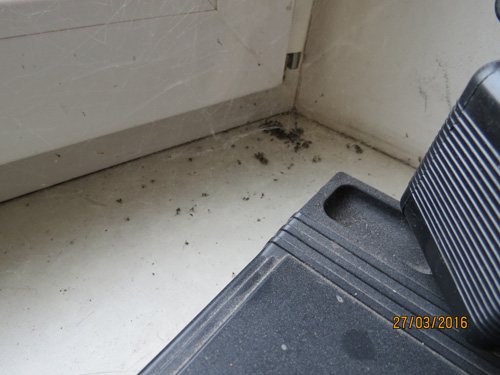

Now I will tell you what remedies have I used against worms?
I've tried solutions like this: potassium permanganate, citric acid, soda, honey tincture (water with honey), and recently (my son suggested) I used Coca-Cola. Remember how this vigorous liquid got rid of red currants from gall aphids, well, and the son suggested trying it against these worms.
Here is the honey trap which so did not attract a single midge ...
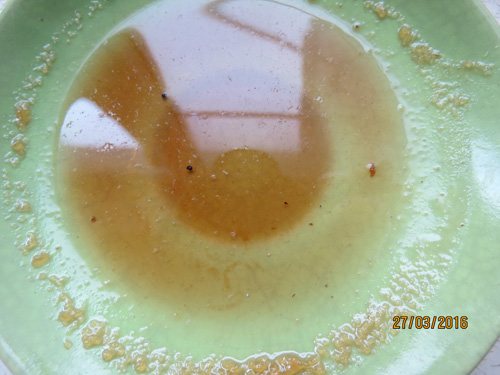

Here is citric acid ...


I also used a plastic bucket from under the cottage cheese with soil in order to divert the laying of midges into this bucket - something like a distraction. True, I didn't sow the seeds in this bucket, but decided to try just the soil?
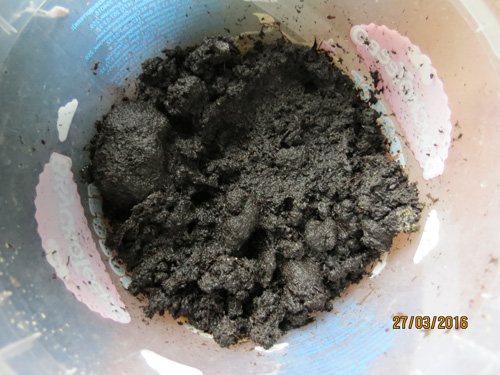

Bucket with soil stands among the seedlings ...


The midge probably laughed at me, And besides, he twisted his paw at his temple - they say, guy, if there is no food in the soil for my offspring (seeds or plants), then why would I lay my eggs there?
Generally, so far, I have no positive results from the use of these remedies for worms and midges. The worms are alive, as are some of the seedlings that I used as an experiment in the same soil where these worms live.
I took out part of the transplanted seedlings to the balcony. True, the time has not yet come to harden the plants (the plants are very tiny), but if they are left in the apartment, the midge will fly in and lay eggs at any moment.
This season only remains that every day to monitor the seedlings and replant them, if suddenly there is a loss of plants even in one cell of the seedling box. I have no other choice - well, I will survive nothing ...
These are the things so far in our seedling kingdom. How many seedlings will remain by the time of planting in open ground and a greenhouse, the Creator alone knows!
But due to these events do I have a plan of action in my head for the next "sowing season"?
Find an effective remedy which specifically can lime this midge in the apartment, because I suspect that she laid eggs in flowers, and in those flower pots in which I grow homemade tomatoes and peppers.
And eliminate this midge before the 2017 sowing season (and subsequent years), otherwise the situation with the death of seedlings will be repeated constantly.
And I also have an opinion about sowing seeds not in seedling boxes, but in separate disposable plastic cups.
Why?
Because if the midge has laid down its clutch in the seedling box, then the worms will crawl all over the seedling box, this is unambiguous. But if you sow the seeds in separate cups, then the midge will postpone, maybe in one or two cups, and the seeds and seedlings in other cups will not be affected.
While other smart thoughts in my head. I proceed from the situation that happened suddenly and exists today.
Here is some photographic material, which I took off during transplant procedures ...
Here is a transplant of peppers ...
Before transplanting the plants themselves brought a solution of soda ...
After plant transplant I left one plant for the experiment, in order to know how the soda solution would act on both the worms and the plant ...


In the photo below is that dead plant, because of which, in fact, the "transplant epic" began ...
See how many worms both in the soil and on the walls of the box section after watering this seedling box with a soda solution ...


On this photo, the same experimental plant that I left to observe (its leaves are twisted into a ring) ...
After waiting until the evening, I did not find any changes in either the plant or the worms - they were alive ...


In the evening I brought in a solution of potassium permanganate and poured them a seedling box with one plant ...
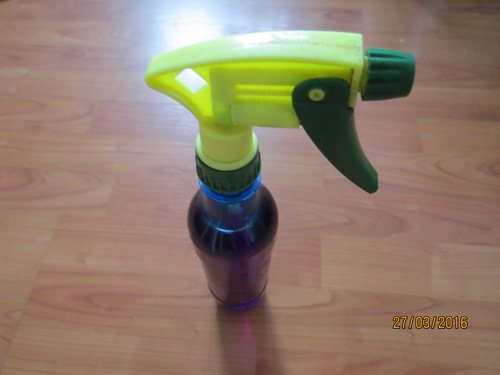

The next day the leaves of the plant turned to their normal position, but the worms remained alive ...
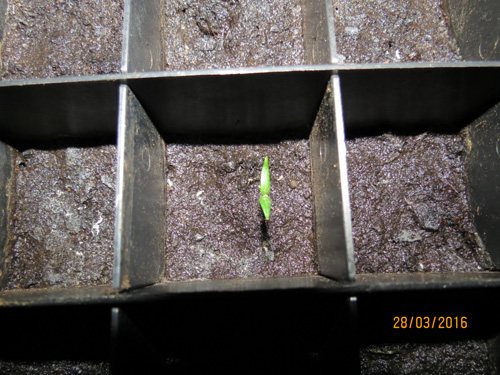

Then I transplanted this plant in a disposable cup, but it was so without roots, it died ...
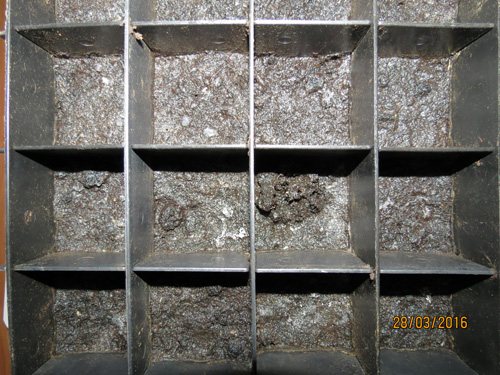

Then I applied citric acid solution and poured over this box again to see what would happen to the worms ...
Nothing significant happened - the worms were alive ...
Well, there was no point in keeping this "incubator" any longer, because from these larvae midges began to hatch. I disassembled the sections and took a photo ...
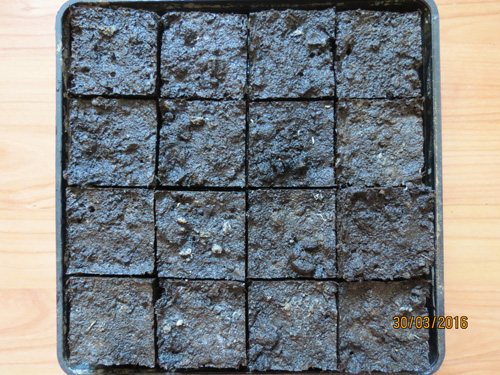

Take a closer look ...
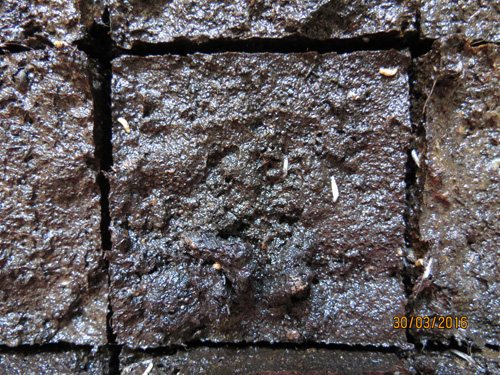

Here is an eggplant transplant ...
Scheduled a transfer on March 28th. I moved the cups from the pallet to the orange bowl, washed the pallet with soap, but did not make a transplant that day (there were other urgent matters) ...
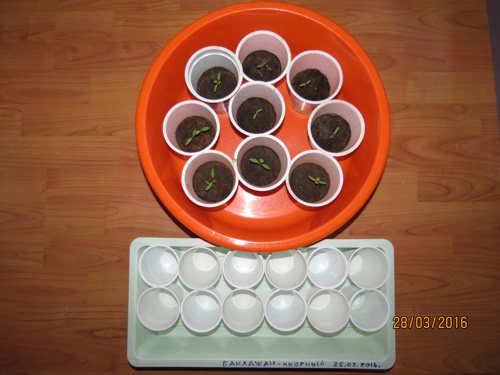

For this day 12 plants could be transplanted ...
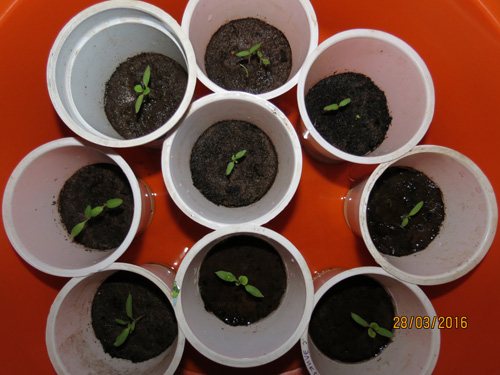

And on March 30 there are already 8 live plants left ...
Here is a tomato transplant ...
Due to the death of pepper seedlings, which I sowed very early this year, I sowed 2-34 tomato seeds per cell, in case some of the plants die, then at least one or two will remain ...
Specifically in this box the seeds were gnawed and did not sprout at all ...
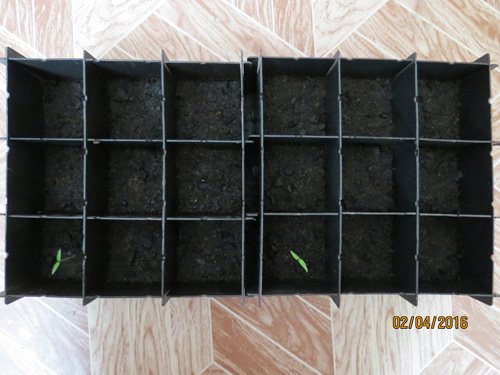

Tomatoes began to die on April 3 and I urgently began to transplant them into disposable plastic cups ...
After plant transplant, I left some live tomato plants for observation and poured Coca-Cola over the soil in a box ...
Nothing happened - the worms were alive ...


After plant transplant, I took the boxes out onto the balcony. Even if the temperature is low there, but the midge does not fly ...


Shortly speaking, the situation this spring is deplorable, but I do not lose my sense of optimism - some of the seedlings will still remain!
If I find an effective remedy from this midge or worms, I will certainly inform you.
This concludes this material ...
Now I have a question for you: "Have you faced such a disaster?"
Your thoughts, suggestions and wishes write in the comments to this post ...
Best regards, Sergei Dyakov.
945
How to water seedlings from midges
The most effective way to prevent pests from laying eggs in the soil is the ability to dry out and loosen the top layer of the earth between waterings. Under tender sprouts, the soil in small containers is loosened with a toothpick; for large seedlings in large pots, loosening of the soil can be done with a table fork.
How to get rid of aphids on seedlings with folk remedies
Moderately dry earth, allowing air to flow to the roots, will prevent them from rotting and becoming food for pest larvae that eat rotting plant tissue. Therefore, a midge that accidentally flew into the room with seedlings will not lay eggs in the dry, loose earth.
It is possible to determine the degree of soil infestation with midge larvae by transplanting several plants and simultaneously examining the soil. If only individual larvae are found in it, there are no tangles with worms, then you can not transplant all the plants, but treat the soil with an infusion of garlic.


To do this, grind a large head of garlic and pour 1 liter of warm water for a day. The ground with seedlings is watered with infusion at least 3 times. After each watering, the soil is allowed to dry out. In order not to harm the plant, do not water all the pots at once, and check the effect of the infusion on 1-2 plants.
Why do midges start?
On the seedlings, you can see not only white, but also black midges. Despite the fact that these insects are street pests, they easily enter the house through the window and take root well in sprout pots.
The tiny black midge sciaris is dangerous for seedlings. She herself does not harm the plants, but her larvae quickly multiply in moist soil and gnaw the roots of the shoots. From this, the seedlings quickly die.
The main reason for the appearance of parasites is excessive watering, especially in the cool season. When the soil is constantly moistened and does not have time to dry out, a comfortable atmosphere is created for the development of larvae.
Often, pests are found in the soil that gardeners buy in the store. It is difficult to notice small larvae until they begin to actively spread, and this happens when the seedlings have already grown and matured enough.
To preserve the plant and get rid of insects for a long time, there are many simple and effective ways.
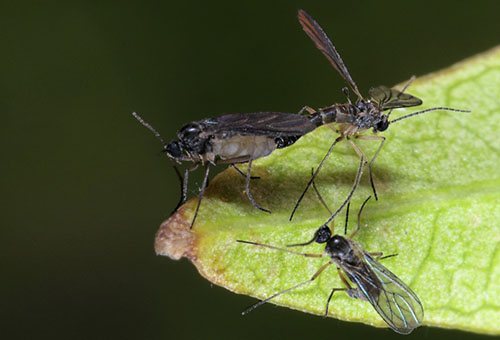

Sciarids - mushroom gnats
Insecticides against midges on seedlings
The fight against small flying insects and their larvae in the soil will be effective if you simultaneously use drugs that are used for surface spraying of plants and soil insecticides. They begin by studying the instructions and determining the required doses.
For processing, choose a non-residential premises, for example, a barn, a balcony or a loggia. If there is no place where plants can be transferred, then the treatment is carried out in protective clothing, a bandage, glasses and gloves. All children, animals and adults not involved in processing must leave the premises.
The processing is carried out with the windows closed. All food, clothes, dishes are put into closets. Before starting work, some of the insects can be collected with a vacuum cleaner. Processing begins with the fact that soil preparations are introduced into the ground, and then the plants are sprayed.


To obtain working solutions, use the manufacturer's recommendations. The soil is watered with soil preparations at least twice with an interval of 5-7 days. After the end of the work, the room is ventilated and wet cleaning is carried out. It is important to rinse out hard-to-reach places where animals and small children can climb.
The drugs that destroy the larvae of pests in the soil include "Thunder-2", "Bazudin", "Pochin", "Mukhoed". For spraying plants use "Karbofos", "Aktara", "Inta-Vir", "Agravertin", "Kinmiks", "Fitoverm", "Aktellik".
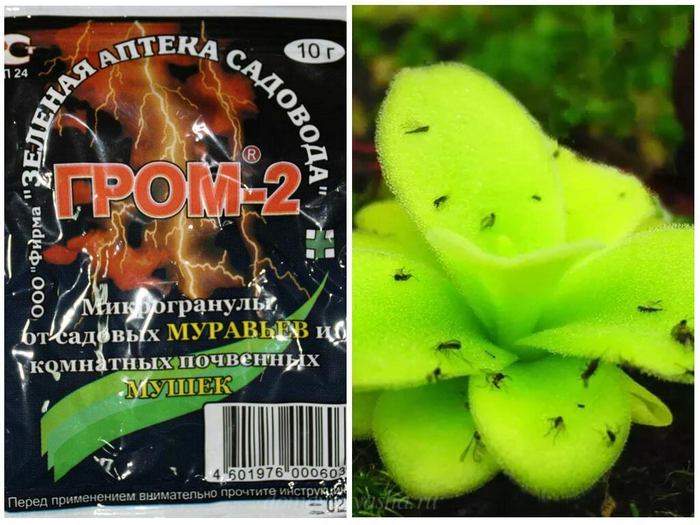

Fumigators
The work of fumigators in the fight against midges will be effective if they are used for more than one day, but at least for 5-7 days. Fumigators (room fumigators) are used with flasks connected to them with liquid fumigants (chemical agents poisonous for insects) or with inserted porous plates impregnated with the same poisons.
To combat fruit midges, use the liquid "Transflutrin" from Bayer AG (Germany), which the manufacturers recommend as a means safe for humans, the "Raptor" fumigator with a nerve agent that is lethal for insects.
How to fight
Once a flower pest is identified, start getting rid of it:
- Send the plant to a secluded location to keep other flowers safe.
- Remove it from the pot, rinse the roots with running water.
- Plant in new calcined soil.
- Give the plant a lull in water: when the soil dries out, the larvae, which vitally need moisture in large quantities, will die.
Calcining the earth is done with the aim of disinfecting it:
- Sprinkle store-bought soil into a baking sheet in an even layer.
- Put it in the oven at 70–90 ° C.
- Leave it on for 30 minutes.
- Then cool the soil and pour it into a pot.
Chemicals
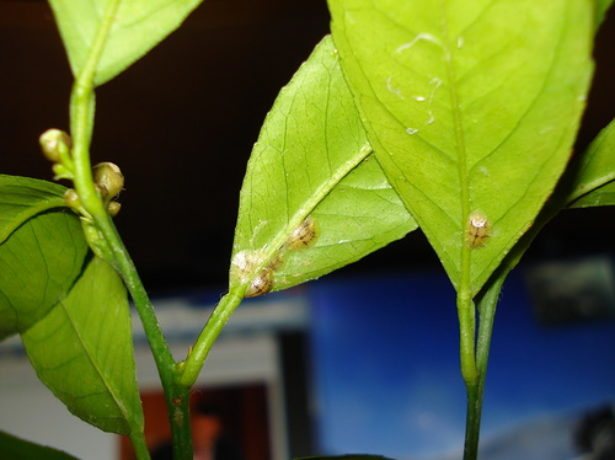

The most popular remedy for annoying midges is Dichlorvos. Gloves and a mask are required during its use as it is toxic.
In flower shops there are insecticidal powders - Aktara, Grom-2 (for soil), Fitoverm, Karbaphos and others. They are diluted with water in the proportions indicated in the instructions, and then used to spray on foliage or water the roots. After treatment with the agent, the flower pot is placed in a plastic bag for 5–7 hours and tied tightly.
Folk remedies
Not every florist is ready to poison his pets, so the use of folk remedies is popular. They are effective, safe and readily available. Use to get rid of insects:
- Potassium permanganate. Dissolve a few grains in water until a pale pink hue is obtained. Water the plant with the solution 2–4 times. Having disinfected the soil, we deprive the larvae of food and they will die on their own.
- Sulfur from matches. Stick the matches with their heads down to a depth of 2-3 cm and pour over with water. Sulfur has a detrimental effect on pests.
- Strong-smelling substances - garlic, tobacco, citrus fruits. Arrange them in pots to scare away insects with the aroma. The smell of garlic scares the midges away from the plant.
- Ammonia. Dilute with water in a ratio of 25 g to 2 liters. Spray foliage, avoiding flowers, and water the soil. The composition will not only kill midges, eggs and larvae, but also have a beneficial effect on the earth as a fertilizer.
- Soap solution. This method is suitable in case of a large number of midges. Dissolve 50 g of grated laundry soap in one liter of water. Then pour the soil over the product and wipe the leaves on both sides.
- Cinnamon. This spice scares off with the smell of adult midges and larvae. Its pleasant aroma in the room will delight all household members.
There are many ways to kill gnats and larvae. The simplest ones are:
- An electrofumigator that you use against mosquitoes.
- Duct tape used to control flies and other flying insects.
- Anti-ant agent in the form of a gel.
Before planting seedlings, it is recommended to carry out a thorough disinfection and disinsection of the soil. If you didn't do it then, consider the procedure now. The most common potassium permanganate will be the best solution for eliminating the larvae. Dissolve several crystals of the drug in one liter of water, then water the seedlings, and then the larvae will turn from pests into good fertilizer.
If you prefer the potassium permanganate method, you can improve it. To do this, use a solution of lemon juice and soap. Just one teaspoon of each component is enough. The method is based on the fact that insects are very fond of an acidic environment and constantly sit on it. However, soap prevents the water from forming a thin film on which midges can sit. Thus, immediately after the insects hit the surface, they simply drown.
If you live in a private house or sprout seedlings in a country house where there is an opportunity to get ash, you can use this method. Wood ash not only helps eliminate grubs and midges, but also fertilizes plants. Thus, you will kill two birds with one stone: you will get rid of the parasite, and you will organize feeding for the growing bushes. The ash is laid in a thick layer.
Another means of pest control is chemical treatment. Today you can buy a huge number of a wide variety of tools that allow you to solve the problem once and for all. The most common are:
- Thunder-2;
- Fly eater;
- Fufanon;
- Aktara.
It is important to select a drug based on the type of plant for which you will be using it. In addition, you should strictly adhere to the instructions for its use. Even ordinary Dichlorvos will be a good solution for processing plants. However, after processing, it is recommended to "hide" the pot in a plastic bag or expose it to the open air. Be careful when working with Dichlorvos, as this product is harmful to your health.
Unfortunately, situations are not uncommon when there are too many midges, and the whole earth is covered with larvae. In this case, traditional methods may be ineffective, get rid of the pests with a transplant. Dig a bush out of the ground, shake off the soil with the larvae from it and transplant it into a pot with disinfected soil. It is recommended to throw out the old soil immediately after transplanting in order to prevent the pest from reappearing.
Growing beautiful tasty tomatoes is difficult. After all, they are trapped by various diseases, they are eaten by insects and aphids. In this article we will talk about white and black gnats, or tomato aphids.
White and black midges, hatching from larvae, live for about 25 days. During the summer, 2-3 generations of them may appear.
The tomato aphid is very prolific, it is difficult to get rid of it later, and therefore it should not be allowed to appear in our garden or in the greenhouse, all sorts of preventive measures must be taken so that the aphid does not start. These are the following actions:
- Aphids are afraid of the cold (below 15ᵒC) - ventilate the greenhouse more often.
- Pull out weeds that midges can inhabit.
- Do not plant densely plants, they will not have enough light and nutrients, weak bushes are easy prey for midges.
- To plant fragrant herbs in the garden (oregano, St. John's wort, calendula, yarrow, wormwood, dill), they will attract insects (bees, wasps, ladybugs, hoverflies) that eat aphids.
- Do not allow anthills in your area, they will also attract aphids (ants are attracted by the sweetish sticky liquid secreted by aphids).
White and black midges on seedlings, how to get rid of at home
At home, they scare away flying insects from seedlings.Midges do not like the smell of cinnamon and hot ground pepper. The soil under the plants is sprinkled with either one of these products, after grinding them, or with a mixture of them in a 1: 1 ratio.
In addition, you can use tobacco dust or ground tobacco. Pots with blooming geraniums are placed next to the seedlings. They do not tolerate the smell of garlic and dry orange peels. They are laid out on the surface of the soil. The edges of the seedling containers can be lubricated with an asterisk balsam containing many different essential oils.
How we defeated the black midge on seedlings
More about mushroom mosquitoes
Fungus gnats are small flies about 2 mm long, usually black in color. They are from the family of leaf gnats, the Latin name is sciara or sciara fly.
They are common pests and are commonly found around most indoor and greenhouse plants. One is home to many overlapping generations all year round at the same time.
Interesting facts from the life of mushroom mosquitoes: * Each female mushroom mosquito can lay up to two hundred microscopic eggs after mating. * Eggs are laid in the soil around the base of the plant and hatch after five to seven days. * Larvae are no more than 1 mm long when they first appear, but can grow up to ten times before they reach pupation.
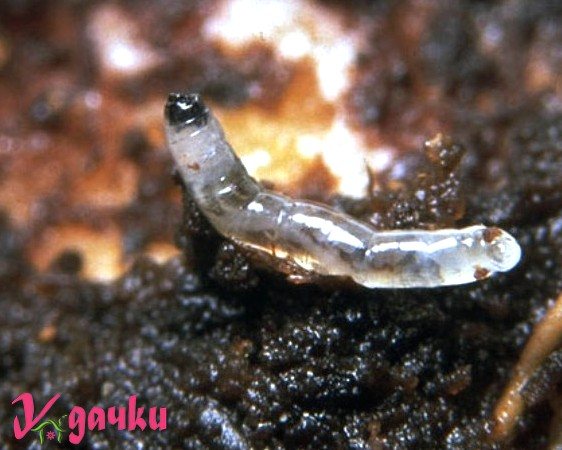

Dangerous larvae of the sciary fly or mushroom gnat
Larvae are difficult to see with the naked eye due to their small size and translucent bodies. They hide under the surface of the soil, where it is moist, and feed mainly on dead organic matter, but can damage the delicate roots of seedlings and the base of soft cuttings. Larvae can also survive on mold spots, greenhouse floors and benches. Interesting facts from the life of the mushroom gnat larvae: * At room temperature, newly hatched larvae will develop into adults in 20-25 days. * During hot seasons in greenhouses, the life cycle can be from one to two weeks.
What to do if the midge is in the seedling ground
Flying insects should not be allowed to enter the house and lay their eggs in the ground with seedlings. In order not to bring the midges into the room along with the purchased fruits and vegetables, it is necessary to hide the peeled peel in tying garbage bags.
There is no need to pour leftover tea or coffee into boxes or glasses with seedlings, because, having rotted, they will become a welcome treat for midges. For seedlings, it is necessary to use containers with large drainage holes in order to prevent stagnation of water on the surface of the earth clod.
Decis for protection against black and white midges on tomatoes, seedlings: recipe for use
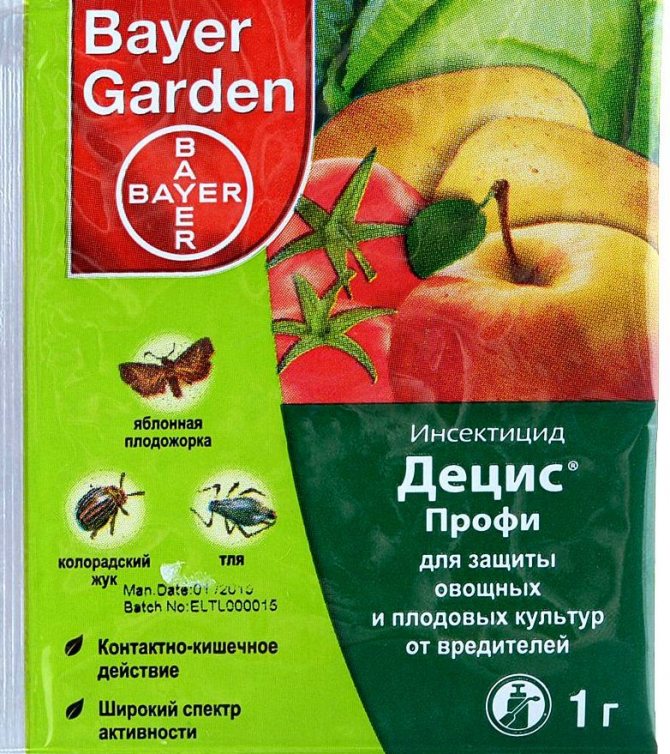

The drug "Decis" for white and black midges
The drug "Decis" refers to pesticides. It is widely used to kill various insects, including aphids, on vegetables, cereals and in the garden. Acts on the nervous system of insects, destroying them. It dissolves well in water. The drug is enough 0.6-1 g per 10 liters of water. Acts quickly, 1 hour after spraying the plants. It is impossible to store the diluted solution, you need to use the whole thing at once. After treatment with the tomato preparation, its effect lasts 14-20 days. It is not addictive to pests.
Important. "Decis" should not be mixed with other drugs that have an alkaline environment.
Prevention and control of sciarid flies
Scaring away insects and cultivating the soil from their larvae will be the first stages of the struggle for a future harvest. Do not forget that the midge is harmful not only because it harms plants. Children can suffer from it, the delicate skin of which can be bitten by female adults of some species of small insects that feed on protein foods.
Therefore, it is necessary to fight the midges not only for the sake of the harvest, but also for the health of your loved ones. Of course, humane methods of scaring away tiny insects are preferred, but very often this does not help. There are many methods of dealing with midges, you just need to make the right choice.
Prophylaxis


Flies appear very often, so it is better to take some measures to prevent their development.
To do this, you need to adhere to certain rules:
- Before planting seedlings, the soil must be prepared. It can be frozen or, conversely, warmed up. This way you can get rid of any pests.
- Do not thicken the planting. Otherwise, not only midges will appear, but the seedlings themselves will grow frail.
- Water the plants sparingly to avoid waterlogging.
- Provide drainage. Pots and boxes should have holes for excess moisture to drain.
- Remove fallen leaves in time.
- Treat plants with preventive treatments for harmful insects. Modern drugs do not pose a danger to human health.
- Do not overuse fertilizers.
- Loosen the soil periodically. The root system must breathe to absorb oxygen more actively.
Even if you could not avoid the appearance of midges, do not be discouraged. Inspect young plants regularly. Finding insects at the first stage will be much easier to eliminate than when they are ubiquitous.
Tips for killing midges from tomato seedlings
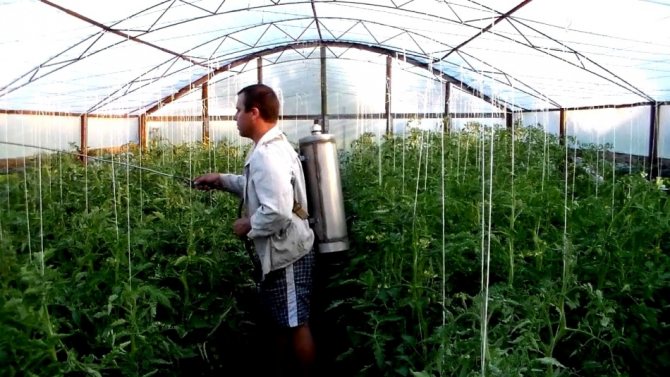

Sprinkling tomato from midges in the greenhouse
Midges can fly from the street if you grow tomato seedlings and on the window. The reason for the appearance of midges is excessive watering during the cold season. The people give a lot of advice on how to get rid of them:
Advice 1. We water the tomato seedlings with a weak, barely pink, potassium permanganate solution.
Tip 2. Sprinkle the ground in which the tomatoes are planted with a thick layer ash, then insects will not be able to hide in the ground.
Tip 3... If you have a lot of tomato seedlings, in the spring, when dandelions appear, do dandelion infusion... It is done like this:
- Pour 1 kg of dandelion plants with roots with 10 liters of boiling water, leave for 1 day.
- We add 1 tbsp. l. bitter pepper and grated laundry soap.
- Spray on tomatoes and soil inhabited by midges.
Tip 4... Water the tomato seedlings with water to which 1 tbsp. l. vinegar in 1 liter of water.
So, now we know how to deal with small white and black gnats on tomatoes.






